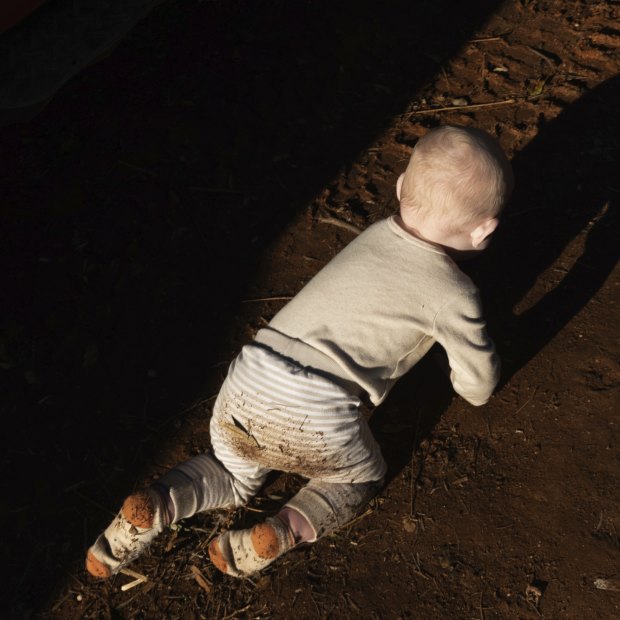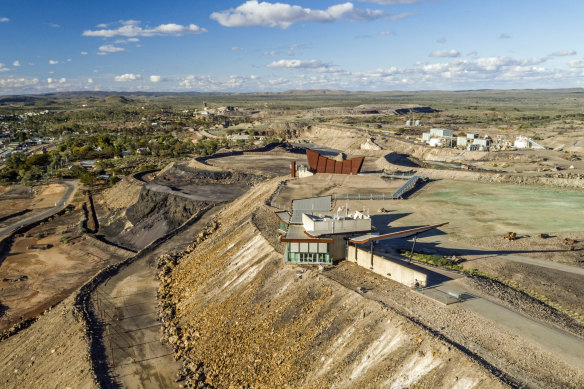This was published 9 months ago
In the shadow of a mining giant, children crawl in poison
Lead levels in children’s blood are on the rise again despite decades of remediation efforts in a town built on one of Australia’s richest mineral deposits.
By Angus Thomson and Rhett Wyman

In Broken Hill, Indigenous children such as Marcus Phillips are exposed to elevated levels of lead. Credit: Rhett Wyman
Marcus Phillips is 12 months old and just beginning to explore the world around him. He picks at paint on windowsills. He smacks dust out of carpets. Outside, he flicks red desert dirt from side to side, scouring the backyard for unknown treasures.
But what the toddler can’t know is this dirt contains poison, dug up from one of the world’s largest lead deposits and blown off slag heaps onto the town below. It is brought inside by prevailing winds and dirty boots to hide in grooves of carpet. It settles on corrugated iron rooftops, ready to be collected by rain and pooled into drains and water tanks. It is painted into the walls of hundreds of Broken Hill’s old miners’ houses.
Lead helped build this town, and now it is slowly poisoning its youngest inhabitants. Lead levels in the blood of Broken Hill children are on the rise again despite decades of remediation efforts, and Aboriginal children are most affected. They have double the amount of lead in their blood compared to non-Indigenous children – well over the threshold for intervention set by the nation’s medical research authority.
“We get pretty revved up about it,” says Lavinia Henderson, who oversees child and family programs at Maari Ma Health Aboriginal Corporation. “Lead is in every single bit of [the work we do], and it’s this extra work, extra stress, extra engagement, and we just don’t get the support.”
Marcus, knees covered in red soil, is playing on the porch when The Sun-Herald arrives at his home in Broken Hill – 13 hours west of Sydney – alongside Maari Ma’s lead monitoring team.
They are here to measure lead levels in the soil, carpet and paint, using a high-powered radiation gun to find hotspots needing remediation.
Marcus’ mother, Makaydee Leayr, points to one area where he likes to play the most. The reading here comes back at more than 800 parts per million – almost three times the threshold for remediation work. In another patch, it’s six times higher.
Encouraged by her sister Tayla, who is part of the Maari Ma health team, Leayr brings Marcus into the clinic for a blood test.
The results come back in minutes: he has just over 4 micrograms per decilitre (μg/dL) of lead in his blood, within the target range of 5 μg/dL set by the National Health and Medical Research Council, but still higher than normal for a child his age.
Even at lower levels, lead can cause issues with a child’s cognition and motor function. As levels increase, the body’s ability to use vitamin D and make red blood cells can decrease. In extreme cases, high lead levels can cause severe anaemia, kidney damage and seizures.
In the latest lead monitoring figures, released by Far West Local Health District last month, the average blood level for children tested between 1 and 5-years-old was 4.4 μg/dL, an increase on the two previous years when testing rates were lower due to COVID-19.
But for Aboriginal children, the average was 7.9 μg/dL. Alarmingly, 1 in 10 Aboriginal children had blood lead levels above 20 μg/dL.
“That’s the stark indicator … that we’re not really closing the gap,” says Hugh Burke, a public health physician who has worked with Maari Ma on the lead issue since 1994.
The Line of Lode
A 10-storey pile of waste material divides North and South Broken Hill. Two companies – Perilya and CBH Resources – still mine the vein that gave BHP its name and riches in the 1800s.
Lead isotopes originating from those mines have been found in blood samples from children and even sparrows. “Very clearly, the Line of Lode [Broken Hill’s iron ore deposit] is still yielding elevated levels of lead dust,” says Mark Taylor, a professor of environmental science and human health at Macquarie University.
‘The Aboriginal children of this community are currently bearing the brunt of the impact.’
Cathy Dyer from Maari Ma Health Aboriginal Corporation
Blood lead levels dropped dramatically in the decade following the introduction of Broken Hill’s lead monitoring program in the mid ’90s. “It was considered probably second only to the success of fluoridation in water as a public health project,” says Cathy Dyer, who has also worked with Maari Ma on its lead response for decades.
But progress has plateaued. The average blood lead level for Aboriginal children tested between one and five years old has stayed above 7 μg/dL in all but one of the last 10 years.
Burke and Dyer say this is partly because a lack of social housing in Broken Hill is disproportionately forcing Aboriginal families into private rentals with lead paint and no landscaping, leaving children to play on bare soil rather than lawns covering the contamination.
The state government has committed more than $200 million towards a “critical maintenance program” for existing Aboriginal housing in NSW, but Burke says new housing was a major priority in Broken Hill. “We can then move Aboriginal families out of those private rental shockers and put them into social housing that is hopefully good quality and lead safe,” he says.
NSW Housing Minister Rose Jackson said the state’s Aboriginal Housing Office had recently completed 10 new homes in Broken Hill, with three more on the way.
But cleaning up houses would be ineffective without stopping new pollution coming from the mines, Taylor says. “You can cap it and clean it – it’s a matter of cost and will.”

Broken Hill is a long-time mining town.
Dyer says Broken Hill has “given an awful lot” to NSW, and it’s time some of those riches are reinvested into its people.
“The wealth that has come out of the ground in Broken Hill … is more than has come out of any other hole in the ground in Australia,” she says. “I think it’s probably reasonable that the NSW government looks at how to safely maintain this community, and certainly the Aboriginal children of this community who are currently bearing the brunt of the impact.”
Perilya and CBH Resources did not respond to requests for comment.
Start the day with a summary of the day’s most important and interesting stories, analysis and insights. Sign up for our Morning Edition newsletter.